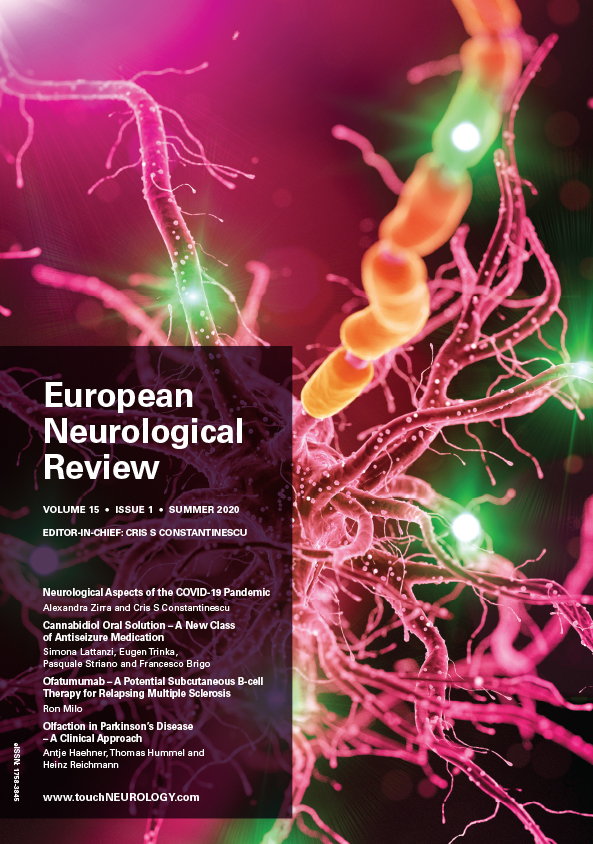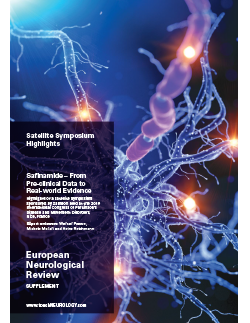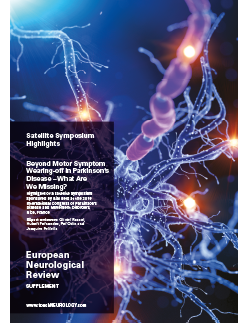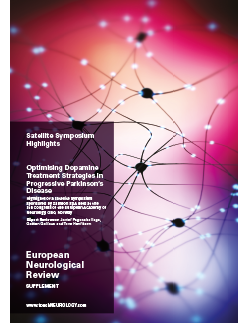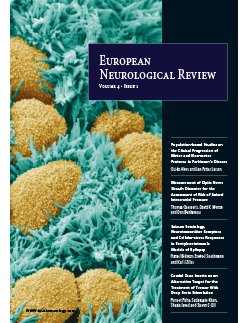
EUROPEAN NEUROLOGICAL REVIEW – VOLUME 4 ISSUE 1 – SUMMER 2009
Foreword
European Neurological Review is an important journal for medical doctors as well as for representatives of pharmaceutical companies and patient organisations. It provides periodic reviews on new developments in neurological disorders. This issue once again covers the main diseases of the brain, such as Alzheimer’s dementia, Parkinson’s disease, traumatic brain injury, stroke, multiple sclerosis, chronic […]
Neurodegenerative Diseases
Alzheimer’s disease (AD) is the most common cause of dementia, with an estimated prevalence of more than 106 million worldwide by 2050.1 It is a neurodegenerative disease characterised by the accumulation of senile plaques (deposits of the β-amyloid peptides) and neurofibrillary tangles (abnormal hyperphosphorylated insoluble forms of the tau protein). Patients with AD often experience […]
Alzheimer’s disease (AD) is a complex, heterogeneous age-related disorder and the most common form of dementia. It is characterised clinically by a decline in cognitive and functional ability and the development of behavioural and psychological symptoms. At a cellular level, it comprises degeneration of neurons and synapses, formation of amyloid plaques and intracellular neurofibrillary tangles.1
As the number of people over 65 years of age continues to rise worldwide, preserving the cognitive health of older adults has become a major societal challenge. The global prevalence of Alzheimer’s disease (AD) was estimated at 26.55 million in 2006 and is expected to quadruple over the next 40 years.1 However, research on successful […]
Alzheimer’s disease (AD) is the most common form of dementia, and worldwide affects 20–30 million individuals over 60 years of age. In 1907 Alois Alzheimer first described AD following an autopsy on the brain of a 55-year-old women who had died following progressive mental deterioration, increasing confusion, and memory loss.
The degeneration of the dopaminergic nigrostriatal system and parkinsonism (rest tremor, rigidity, bradykinesia and postural instability/gait disorder) represent only one aspect of Parkinson’s disease (PD), a multifaceted and complex disorder.1 In addition to this typical motor dysfunction, non-motor symptoms (NMS) also significantly reduce of quality of life.2–4 Several non-motor features are associated with deficits in […]
The initiation of antiparkinsonian treatment in early Parkinson’s disease (PD) is followed by a phase of good to excellent symptomatic response in nearly all patients; this has been referred to as the ‘honeymoon phase’. A stable response may be sustained in some patients throughout the course of their illness, but the majority will go on […]
Parkinson’s disease (PD) is most commonly recognised as a movement disorder disease. Accordingly, motor symptoms (MS) have been the focus when making diagnoses, prescribing treatment and assessing its effect. Considerable progress has been made in all three areas and effective therapies are now available to improve the quality of life (QoL) of PD patents with […]
Parkinson’s disease (PD) is the most common neurodegenerative movement disorder, affecting more than one million people in Europe. The cardinal features of the disease include resting tremor, bradykinesia, rigidity and postural abnormalities. Long understood as a solely movement disorder caused by progressive neuronal cell loss and dopamine depletion in the nigrostriatal system, PD is today […]
Parkinson’s disease (PD) is a common neurodegenerative disorder characterized by dopaminergic neuronal loss in the substantia nigra and other brain areas. Despite the vast majority of cases being sporadic, at least six genes have been identified so far that are responsible for autosomal dominant or recessive forms of parkinsonism. The PARK6 locus was mapped to […]
Brain Trauma
Primary intracerebral haemorrhage (PICH) originates from the spontaneous rupture of small arteries as a result of chronic degenerative changes due to chronic hypertension or amyloid angiopathy.1 Although environmental factors are important, there is accumulating evidence that genetic elements also contribute to the pathogenesis of PICH.2,3 In an epidemiological study, familial clustering of PICH was noticed, […]
Raised intracranial pressure (ICP) is frequent and is associated with poor outcome after brain injury, and also after liver failure, acute ischaemic stroke, cerebral venous thrombosis, meningitis and encephalitis.1–5 However, the early detection of raised ICP can be difficult when invasive devices are not available. Clinical signs of raised ICP are not specific and are […]
Individualised Treatment Considerations in Stroke Prevention Peter M Rothwell Professor of Clinical Neurology, University of Oxford This article serves as an introduction to the problems and potential benefits of trying to target stroke treatments at individuals rather than simply prescribing a one-size-fits-all regimen. There are a range of opinions on whether it is possible to […]
Stroke is a major public health burden worldwide that demands continued research to improve treatment and prevention. However, stroke presents a number of practical and ethical challenges to research due to its unpredictability, apoplectic onset, and potential to render individuals incapable of providing informed consent. Disagreements regarding appropriate safeguards for subjects are as old as […]
Multiple Sclerosis
The SH2D2A gene encodes a cytoplasmic adapter protein, T-cell-specific adapter protein (TSAd), which is expressed in activated T cells as well as in endothelial cells. Several lines of evidence imply a contribution of this gene to susceptibility to the development of multiple sclerosis (MS). In this article we will review current evidence, and point to […]
Chronic Inflammatory Demyelinating Polyneuropathy
Chronic inflammatory demyelinating polyradiculoneuropathy (CIDP) is a significant source of disability1 and commonly presents as a progressive, symmetrical weakness in both proximal and distal muscles.2 Underdiagnosis remains a concern, but the prevalence of CIDP worldwide is estimated to be up to eight individuals per 100,000 of the population1,3–8 and it accounts for ~14% of cases […]
Epilepsy
Epilepsy affects about 1% of the human population at some point during their life. The causes of human epilepsies are diverse, ranging from defects during brain development resulting in dysplasias or ectopic cortical neurons to inherited forms involving certain mutations, e.g. ion channel defects or metabolic impairments; however, most causes are still unknown.1,2 Furthermore, post-traumatic […]
Imaging
Dementia with Lewy bodies (DLB) is a common form of dementia. The characteristic features are: progressive dementia particularly affecting attention, visuo-spatial and executive ability; fluctuating cognition; spontaneous parkinsonian symptoms; persistent vivid visual hallucinations; hypersensitivity to neuroleptic medication; and rapid eye movement (REM) sleep behavioural disorder.1 Patients with DLB frequently have mixed pathology, and the presence […]
Perfusion is defined as the steady-state delivery of nutrients and oxygen via blood to tissue per unit volume or mass and is typically measured in milliliters per 100g of tissue per minute.1 Because blood flow brings crucial nutrients, and because it is disturbed in many disease processes, monitoring of this key physiological parameter can often […]
Surgery
Caudal Zona Incerta as an Alternative Target for the Treatment of Tremor with Deep Brain Stimulation
Tremor is defined as a rhythmic, involuntary oscillation that can affect the upper and lower extremities, head, jaw, face, tongue, voice and trunk.1 Irrespective of the aetiology, tremor has a detrimental effect on the patient’s quality of life. Surgery is offered when tremor is functionally disabling and medically refractory, or when patients develop complications from […]
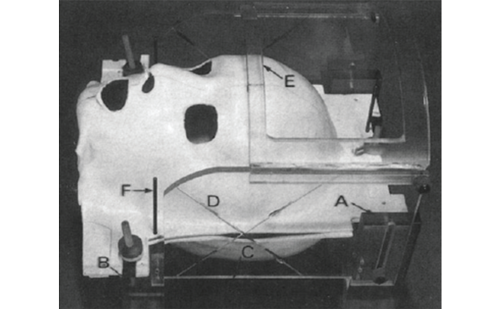
Trending Topic
Intracranial radiosurgery, no matter the means or methods of administration, is predicated on a core set of principles, including head immobilization and precise delineation of the treatment target. For some five decades after Leksell introduced the concept of stereotactic radiosurgery in 1951,1 rigid head fixation via an invasive device was an integral component towards these ends. […]
Journal Archive
European Neurological Review is a peer-reviewed, free-to-access, bi-annual neurology journal comprising review articles, case reports, practice guides, theoretical discussions, and original research. It features balanced and comprehensive articles written by leading authorities, addressing the most important and salient developments in the field of neurology in practical terms.
Latest articles videos and clinical updates - straight to your inbox
Log into your Touch Account
Earn and track your CME credits on the go, save articles for later, and follow the latest congress coverage.
Register now for FREE Access
Register for free to hear about the latest expert-led education, peer-reviewed articles, conference highlights, and innovative CME activities.
Sign up with an Email
Or use a Social Account.
This Functionality is for
Members Only
Explore the latest in medical education and stay current in your field. Create a free account to track your learning.


